

Macau. Hong Kong. Special administrative region of China Special administrative region in China Hong Kong (; Chinese: 香港, Cantonese: [hœ́ːŋ.kɔ̌ːŋ] ( Hong Kong became a colony of the British Empire after Qing China ceded Hong Kong Island at the end of the First Opium War in 1842.[16] The colony expanded to the Kowloon Peninsula in 1860 after the Second Opium War, and was further extended when Britain obtained a 99-year lease of the New Territories in 1898.[17][18] The territory was returned to China in 1997.[19] As a special administrative region, Hong Kong maintains separate governing and economic systems from that of mainland China under the principle of "one country, two systems".[20] Etymology History After the Qing conquest, maritime trade was banned under the Haijin policies.

In 1839, the Daoguang Emperor rejected proposals to legalise and tax opium and ordered imperial commissioner Lin Zexu to eradicate the opium trade. Immediately after the transfer, Hong Kong was severely affected by several crises. Outer Manchuria. Outer Manchuria is in light red on this map.
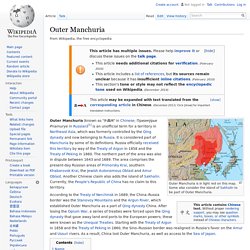
Some also consider the island of Sakhalin to be part of Outer Manchuria. Outer Manchuria (known as "外滿洲" in Chinese; Приаму́рье Priamurye in Russian)[1] is an unofficial term for a territory in Northeast Asia, which was formerly controlled by the Qing dynasty and now belonging to Russia. East Asian cultural sphere. The "Sinosphere", or "East Asian cultural sphere", refers to a grouping of countries and regions in East Asia that were historically influenced by the culture of China.
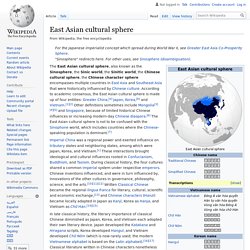
Other names for the concept include the Sinic world, the Confucian world, and the Chinese cultural sphere, though the last is also used to refer particularly to the Sinophone world: the areas which speak varieties of Chinese. The East Asian cultural sphere shares a Confucian ethical philosophy, Buddhism, and, historically, a common writing system. The core regions of the East Asian cultural sphere are China (People's Republic of China), Taiwan (Republic Of China), North Korea, South Korea, Ryukyu Islands, Japan and Vietnam. Although Mongolia and parts of Central Asia are sometimes included and perhaps more on an ethnic basis, and also from some ancient cultural connections. Academic usage[edit] Arnold J. British historian Arnold J. Nishijima Sadao[edit] Edwin O. The American Sinologist and historian Edwin O.
Samuel P. Taiwan. State in East Asia Coordinates: The political status of Taiwan remains uncertain.
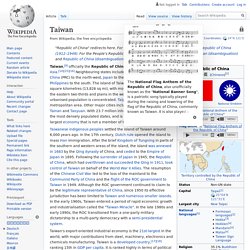
The ROC is no longer a member of the UN, having been replaced by the PRC in 1971. Taiwan is claimed by the PRC, which refuses diplomatic relations with countries that recognise the ROC. Taiwan maintains official ties with 14 out of 193 UN member states and the Holy See.[22][23] International organisations in which the PRC participates either refuse to grant membership to Taiwan or allow it to participate only on a non-state basis. Etymology Various names for the island of Taiwan remain in use today, each derived from explorers or rulers during a particular historical period. Mongolia. Large country in East Asia Mongolia (, Mongolian: Монгол Улс, transcription: Mongol Uls, Traditional Mongolian: ᠮᠤᠩᠭᠤᠯ ᠤᠯᠤᠰ, transliteration: Mongγol ulus) is a landlocked country in East Asia.
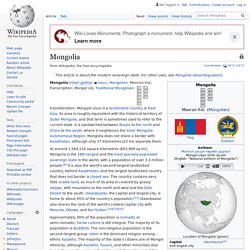
Its area is roughly equivalent with the historical territory of Outer Mongolia, and that term is sometimes used to refer to the current state. It is sandwiched between Russia to the north and China to the south, where it neighbours the Inner Mongolia Autonomous Region. Mongolia does not share a border with Kazakhstan, although only 37 kilometres (23 mi) separate them. South Korea. South Korea ( listen), officially the Republic of Korea (Hangul: 대한민국; hanja: 大韓民國; RR: Daehan Minguk, listen; lit.

North Korea. Coordinates: North Korea, officially the Democratic People's Republic of Korea (abbreviated as DPRK or DPR Korea), is a sovereign state in East Asia constituting the northern part of the Korean Peninsula.

Officially, its territory consists of the whole Korean Peninsula and its adjacent islands. Pyongyang is the nation's capital and largest city. East Asia. East Asia or Eastern Asia is the eastern subregion of the Asian continent, which can be defined in either geographical[1] or cultural[2] terms.
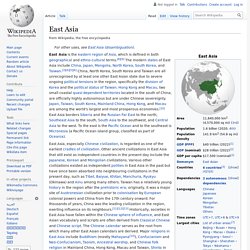
Geographically and geopolitically, it covers about 12,000,000 km2 (4,600,000 sq mi), or about 28% of the Asian continent, about 15% bigger than the area of Europe. More than 1.5 billion people, about 38% of the population of Asia and 22% or over one fifth of all the people in the world, live in East Asia. The region is one of the world's most populated places, with a population density of 133 inhabitants per square kilometre (340/sq mi), being about three times the world average of 45/km2 (120/sq mi), although Mongolia has the lowest population density of a sovereign state. Using the UN subregion definitions, East Asia ranks second in population only to Southern Asia. History[edit] As connections began to strengthen with the Western world, China's power began to diminish. Extrême-Orient. Un article de Wikipédia, l'encyclopédie libre.
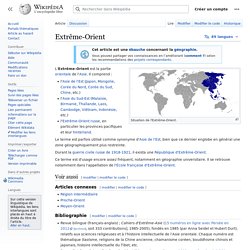
Situation de l'Extrême-Orient L'Extrême-Orient est la partie orientale de l'Asie. Il comprend : Le terme est parfois utilisé comme synonyme d'Asie de l'Est, bien que ce dernier englobe en général un concept géographiquement plus restreint. Il exista aussi durant la guerre civile russe de 1918-1921, une République d'Extrême-Orient. Ce terme est d'usage encore assez fréquent, notamment en géographie universitaire. Asie de l'Est. Un article de Wikipédia, l'encyclopédie libre.

L'Asie de l'Est (ou Asie orientale) est une région d'Asie, comprenant : la Chinela Corée (Corée du Nord et Corée du Sud) ;le Japon ;la Mongolie (parfois rattaché à l'Asie centrale) ;Taïwan ;éventuellement le Viêt Nam et Singapour, pour des raisons culturelles (ces pays sont plus généralement rattachés à l'Asie du Sud-Est pour leur position géographique) ;l'Extrême-Orient russe peut aussi être rattaché à cette régions. Elle est couramment associée à la notion d'Extrême-Orient. Géographie[modifier | modifier le code]